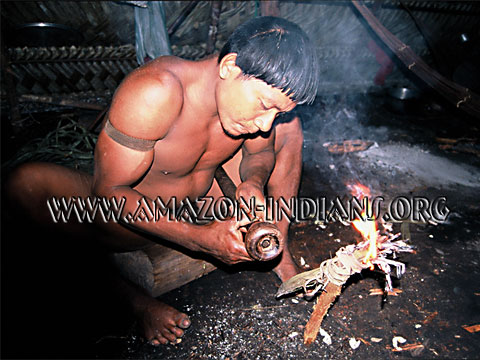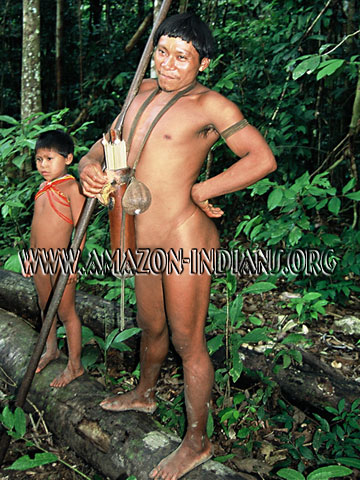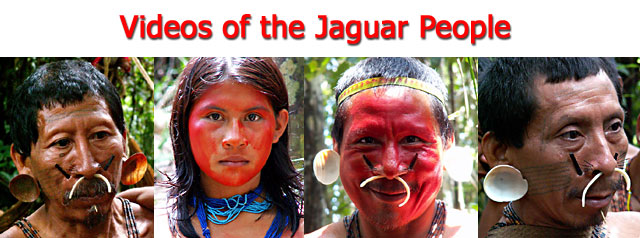
Korubo Indians: The Head-BashersBy Charito Ushiñahua |
|
|
|
|

|
|
he Korubo Indians are the most recent previously uncontacted Amazonian tribe to be contacted. The Korubos are said to have been initially discovered by the outside world in the year 1996. Subsequently, the Korubo tribe became known as the Caceteiros by the local people in Brazil. The word caceteiro means "club-wielders" in Portuguese and refers to their carrying clubs as weapons to defend themselves. However, newspaper reporters began calling them the "Head-Bashers" and this might be due to a mistranslation by a French anthropologist of the Portuguese word caceteiro which is similar to the French word casse-tête which literally means "break-head." Until relatively recently, the use of war clubs by indigenous people was not uncommon in the Amazon, and the men in the Shipibo tribe only stopped carrying clubs within the last generation.
Although the first peaceful contact with the Korubo occurred in 1996, the Brazilian government has known about them for many years. In the book, Polvos Indígenas no Brasil, Javari, Volume 5 (Indigenous People of Brazil, Javari, Volume 5) published by the Brazilian government, the Korubos are referred to simply as the "Indios da confluência do Ituí com o Itacoaí" (Indians from the confluence of the Itui and Itaquai Rivers). The book dedicates a chapter to the Korubo, showing photographs of them taken from passing boats and reviews their history of contact with the outside world. According to the book, in 1928 a group composed of a Brazilian, a Peruvian, and five members of the Ticuna tribe encountered the Korubos and a battle followed during which over forty Korubos were shot and killed. The Korubos were reported to have used spears and clubs as weapons, lacking the use of bows and arrows. Subsequent violent encounters with the Korubos occurred and records of the Policia Federal (Federal Police of Brazil) report at least 33 fatalities of Brazilians due to fatal encounters with the Korubos.
More recently, relations with this band of Korubos improved. In fact, they were featured in a Discovery Channel documentary and National Geographic and Smithsonian Magazine articles. Paradoxically, the FUNAI has allowed access to the Korubo tribe by the media and journalists, but has denied access to them by anthropologists. Therefore, scientists know very little about the Korubo. One would think that the FUNAI would want to learn more about the culture of these indigenous Amazonians so that they could better care for them. Allowing selected members of the press access to the Korubos is an obvious attempt by FUNAI officials to shed their governmental agency in favorable light. Their strategy has seemed to have worked and there is little international criticism of their policies and management of indigenous people in the Javari Valley. Recently, the FUNAI has been arming the Korubos with shotguns in order to defend themselves. This is a controversial policy, to say the least, yet no criticisms have surfaced in the popular press. One FUNAI policy I do agree with is that the main group of uncontacted Korubos should be left alone and allowed to live in voluntary isolation. However, not all anthropologists agree, and a controversial French anthropologist (Philippe Erikson) who studied the Matis has argued that the uncontacted Korubos must be contacted. He sites the first encounter of outsiders with the Matis, during which disease epidemics wiped out most of the tribe, yet he offers no suggestions on how things could be done differently with the Korubos in order to avoid such a tragedy. In any case, at the present the Korubos living in voluntary isolation have not shown any desire to be contacted. However, this could change in the near future as people from the small contacted group of Korubos make contact once again with the larger group of uncontacted Korubos. One can only hope that the culture of these native Amazonians survives the challenges of the modern world. The author, Charito Ushiñahua, is an anthropologist working for the preservation of indigenous Amazonian cultures. For more information on how you can help indigenous people of the Amazon Rainforest in their struggle for survival, please email info@amazon-indians.org.
|

 Permanent
contact with the Korubo did not occur until the Brazilian government agency
FUNAI (Fundação
Nacional do Índio), whose mission it is to protect the rights of indigenous
people, decided to install a permanent post at the confluence of the Itui and
Itaquai Rivers in 1996. The function of the post was to prevent
non-indigenous people from entering the new reserve that was recently created
for the various tribes that live in the region. Subsequently, a small
group of twenty-three Korubos, made contact with FUNAI personnel at the post.
This group of Korubos is a splinter group of the main group of Korubos which is
estimated to number 150 individuals. Perhaps not surprisingly, considering
the history of how the Korubos have defended their lands, subsequent violent
encounters with the FUNAI occurred, and seven of their agents perished.
Permanent
contact with the Korubo did not occur until the Brazilian government agency
FUNAI (Fundação
Nacional do Índio), whose mission it is to protect the rights of indigenous
people, decided to install a permanent post at the confluence of the Itui and
Itaquai Rivers in 1996. The function of the post was to prevent
non-indigenous people from entering the new reserve that was recently created
for the various tribes that live in the region. Subsequently, a small
group of twenty-three Korubos, made contact with FUNAI personnel at the post.
This group of Korubos is a splinter group of the main group of Korubos which is
estimated to number 150 individuals. Perhaps not surprisingly, considering
the history of how the Korubos have defended their lands, subsequent violent
encounters with the FUNAI occurred, and seven of their agents perished. 